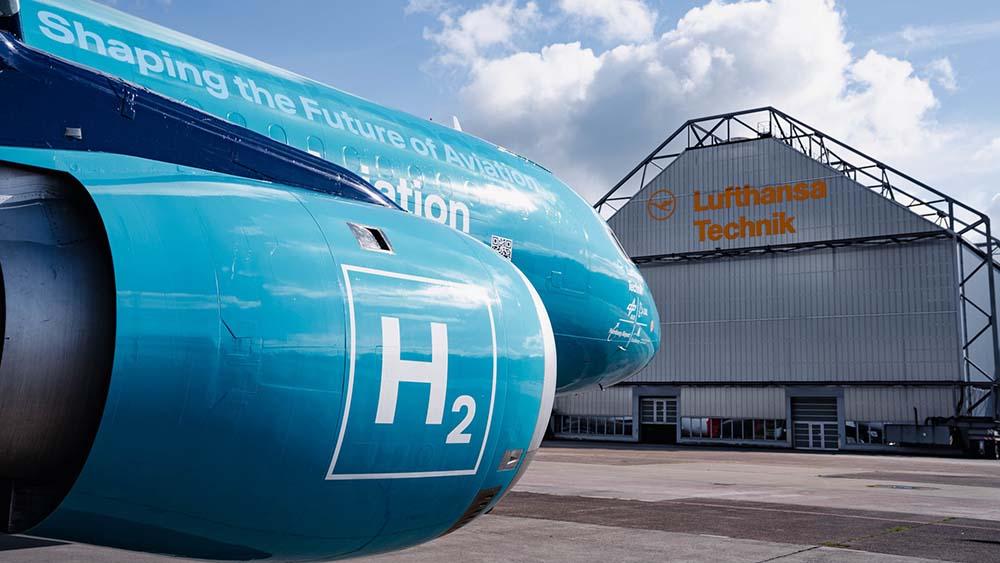
The Airbus A320 Lufthansa Technik is using to test maintenance and ground processes for future hydrogen-powered aircraft.
Several MROs are making progress on sustainability through a variety of initiatives, ranging from green aircraft modifications to more eco-friendly hangar operations.
AAR released its 2022 Environmental, Social and Governance Report on Oct. 31, which highlighted several new sustainability initiatives across the company. Using an independent third-party consultant, it has been collecting and reporting environmental data across its company over the past two years, which it is evaluating to develop strategies that will help it reduce its environmental impact.
One major area in which this data has helped reduce AAR’s carbon footprint is through tracking and monitoring energy consumption across its sites, such as natural gas, propane, gasoline and diesel. AAR says it has decreased its energy usage this year by 10% and its emissions by 9% compared to 2021 through a variety of methods. These include implementation of higher-efficiency LED lighting, replacing HVAC systems with more efficient units, replacing a diesel fuel-powered aircraft tug with an electric tug and setting thermostats to low-impact operation during off hours.
To further conserve resources, AAR says it has also been implementing measures to reduce water consumption. At its Trois-Rivieres facility in Quebec, it installed filtered water fountains and provided staff with reusable water bottles to reduce the use of plastic bottles. In Cadillac, Michigan it installed a chiller to recirculate chilled water, which it says has reduced water and sewer usage.
At various sites AAR is recycling materials—such as paper, cardboard, plastic and metal—as well as batteries used in items such as forklifts, headlamps and flashlights. It also purchased a paint-separating machine for its Windsor, Ontario facility, which lets it reuse acetone and dispose of waste as a solid, which AAR says will reduce possible spills and leakages.
This summer AAR also invested in Boeing 737 drag reduction kits through a collaboration with Aero Design Labs, which it says has the potential to reduce fuel consumption and carbon emissions. AAR has been supporting the kit’s development and will distribute the kit to airline customers.
Another MRO working on greener aircraft modification technologies is Lufthansa Technik (LHT). Its parent company, Lufthansa Group, created a team called CleanTech Hub in summer 2021 that is developing methods to reduce waste in aircraft operations and make aircraft lighter and more aerodynamic. Its aftermarket-related projects include AeroSHARK, a surface technology developed by LHT and coatings specialist BASF that the companies say can save around 1.1% of fuel and carbon dioxide emissions by reducing frictional resistance.
Another CleanTech Hub project making progress is The Hydrogen Lab, a research project to test maintenance and ground processes for future hydrogen-powered aircraft. LHT just unveiled the Airbus A320 that will serve as the project’s field laboratory on Oct. 28. It will begin installing hydrogen components in the coming months, including a full suite of test systems, an internal tank for liquid hydrogen and an onboard fuel cell.
Meanwhile, AFI KLM E&M is recycling plastic bottles from aircraft to create 3D printed parts. KLM is collecting empty plastic bottles at the end of its flights, which it transforms into filament—the material used in 3D printers. According to a spokesperson for AFI KLM E&M, the airline previously bought filament from external suppliers. However, it now delivers the empty plastic bottles to a recycling company in exchange for high-quality plastic pellets. AFI KLM E&M then uses this material to create tools for repairing and maintaining aircraft.
AFI KLM E&M is also using 3D printing to create non-critical aircraft cabin parts. According to Ahmoss Messayeh, innovation director at AFI KLM E&M, additive manufacturing is “a very important issue” for the company. While the MRO is currently focused on cabin parts, Messayeh says it would like to eventually move into more critical parts. It is working to study what parts could be 3D printed and how to get OEM approval.
Messayeh says AFI KLM E&M is also prioritizing sustainability in its efforts to create a “hangar of the future,” including reducing energy waste in areas such as heating.





